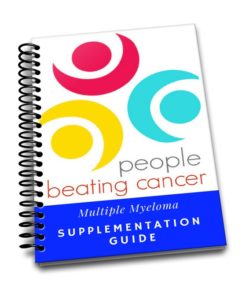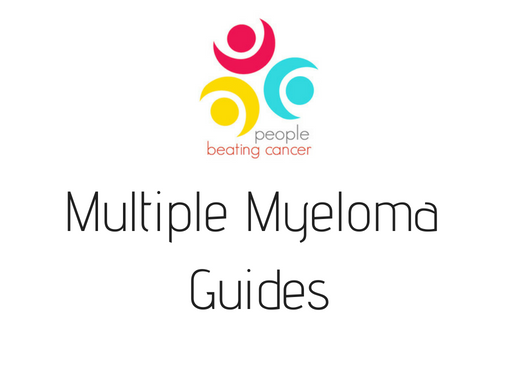A group of molecules that helps form new blood vessels — a process called angiogenesis — is known to be involved in the growth and activity of multiple myeloma…
Thalidomide, revlimid, curcumin, resveratrol and even cannabidiol are angiogenesis inhibitors. All of these multiple myeloma therapies shown to inhibit the growth of multiple myeloma.
According to the study linked and excerpted below, oncology may be able to measure a newly diagnosed MM patient’s response to anti-angiogenic chemotherapy regimens such as thalidomide and revlimid based on a group of molecules that helps form new blood vessels in the blood.

To look at this issue a different way, have you ever wondered why some people seem to respond to certain chemotherapy regimens while others do not? Maybe those who respond to thalidomide and revlimid may be more likely to benefit from inhibitors of blood vessel growth. Taking angiogenesis inhibitors, whether chemotherapy, nutritional or supplementation, hits their MM hard and they enjoy a longer PFS and OS.
Taking the ideas discussed below a step further, “identifing patients more likely to benefit from inhibitors of blood vessel growth,” may identify those MMers who respond to combining therapies that synergize.
Lastly and perhaps most importantly, the ideas put forth below help steer the newly diagnosed MMer away from the high-dose chemotherapy approach and more toward a targeted approach-at least for those MMers who have the specific molecules mentioned in the article.
Have you been diagnosed with MM? What stage? To learn more about angiogenesis, scroll down the page, post a question or comment and I will reply to you ASAP.
Thank you,
David Emerson
- MM Survivor
- MM Cancer Coach
- Director PeopleBeatingCancer
Recommended Reading:
“A panel of blood markers that identifies tumors with more active blood vessels may help stratify multiple myeloma patients according to their risk, a study found. It may also identify patients more likely to benefit from inhibitors of blood vessel growth.
The study, “Prognostic or predictive value of circulating cytokines and angiogenic factors for initial treatment of multiple myeloma in the GIMEMA MM0305 randomized controlled trial,” was published in Journal of Hematology & Oncology….
Yet determining which patients are more likely to respond to therapy remains imprecise; available monitoring tools, such as imaging, do not always accurately predict treatment outcomes…
A group of molecules that helps form new blood vessels — a process called angiogenesis — is known to be involved in the growth and activity of multiple myeloma. So researchers asked whether analyzing the levels of some of these molecules might help predict clinical outcomes for multiple myeloma patients.
The specific molecules the researchers analyzed were
- angiopoietin-2 (ANG-2),
- fibroblast growth factor-2 (FGF-2),
- hepatocyte growth factor (HGF),
- interleukin-8 (IL-8),
- platelet-derived growth factor-B (PDGF-B),
- tissue inhibitor of matrix metalloproteinase-1 and
- -2 (TIMP-1, TIMP-2),
- tumor necrosis factor-alpha (TNF-α), and
- vascular endothelial growth factor (VEGF).
All of these are involved in angiogenesis…
The researchers used data from a recent clinical trial, called GIMEMA MM0305 (NCT01063179). in which levels of these markers in the bone marrow and blood had been analyzed at diagnosis in 124 multiple myeloma patients. The study also included 54 healthy controls.
The researchers found that blood and bone marrow levels of these markers were the same, meaning that testing with this panel could be done through less invasive blood tests.
The levels of all of the studied markers were higher in multiple myeloma patients than in healthy controls. Furthermore, all of the markers except for TIMP-1 and TIMP-2 were predictive of response to treatment, with lower levels accompanied by better responses.
Low levels of FGF-2 and VEGF were found to be associated with longer progression-free timespans and overall survival, regardless of the treatment patients had received.
Using these markers, the researchers developed a risk stratification system: patients with elevated FGF-2 and VEGF were considered at high risk; patients with high levels of only one factor were considered at intermediate risk; and those with low levels of both markers were at low risk.
While the median survival for those at low risk was 70 months, patients at intermediate and high risk lived for a median of 62 and 34 months, respectively. Similarly, low-risk patients remained without disease progression for a median of 44 months, compared to 23.5 months for intermediate risk, and 14.5 months for high-risk patients.
Together, these markers were better at predicting prognosis than current predictive systems such as the International Staging System in the studied patients, showing the predictive power of this test.
The researchers hope that this system might allow patients at high risk to receive more appropriate care, noting that they “might have a more aggressive disease course but are likely to derive relative benefit from inhibition of angiogenic pathways.” They further suggest that medications targeting blood vessel stability and growth or certain aspects of the tumor environment might be particularly beneficial for this group of patients.”




